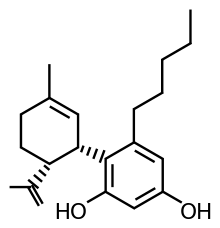Abnormal cannabidiol
 | |
| Systematic (IUPAC) name | |
|---|---|
|
4-[(1S,6R)-3-methyl-6-prop-1-en-2-ylcyclohex-2-en-1-yl]-5-pentylbenzene-1,3-diol | |
| Identifiers | |
| CAS Number |
78216-32-7 |
| PubChem | CID 3060519 |
| ChemSpider |
2321442 |
| Chemical data | |
| Formula | C21H30O2 |
| Molar mass | 314.46 |
| |
| |
| | |
Abnormal cannabidiol (abn-cbd) is a synthetic regioisomer of cannabidiol, which unlike most other cannabinoids produces vasodilator effects, lowers blood pressure, and induces cell migration, cell proliferation and mitogen-activated protein kinase activation in microglia, but without producing any psychoactive effects.[1][2] It has been shown that the actions of abnormal cannabidiol are mediated through a site separate from the CB1 and CB2 receptors,[2][3] which responds to abnormal cannabidiol, O-1602, and the endogenous ligands: anandamide (AEA), N-arachidonoyl glycine (NAGly) and N-arachidonoyl L-serine.[2][4][5][6] Multiple lines of evidence support the proposed identification of this novel target in microglia as the previously "orphan" receptor GPR18.[2] Another possible target of abnormal cannabidiol is GPR55, which has also received much attention as a putative cannabinoid receptor,[7][8] although a growing body of evidence points to lysophosphatidylinositol (LPI) as the endogenous ligand for GPR55.[9][10] Further research suggests there are yet more additional cannabinoid receptors.[11][12][13][14]
See also
References
- ↑ Adams, MD; Earnhardt, JT; Martin, BR; Harris, LS; Dewey, WL; Razdan, RK (1977). "A cannabinoid with cardiovascular activity but no overt behavioral effects". Experientia 33 (9): 1204–1205. doi:10.1007/BF01922330. PMID 891878.
- 1 2 3 4 McHugh D, Hu SS, Rimmerman N, Juknat A, Vogil Z, Walker JM, Bradshaw HB (March 2010). "N-arachidonoyl glycine, an abundant endogenous lipid, potently drives directed cellular migration through GPR18, the putative abnormal cannabidiol receptor". BMC Neuroscience 11: 44. doi:10.1186/1471-2202-11-44. PMC 2865488. PMID 20346144.
- ↑ Jarai, Z. (1999). "Cannabinoid-induced mesenteric vasodilation through an endothelial site distinct from CB1 or CB2 receptors". Proceedings of the National Academy of Sciences 96 (24): 14136–14141. doi:10.1073/pnas.96.24.14136. PMC 24203. PMID 10570211.
- ↑ Walter, L; Franklin, A; Witting, A; Wade, C; Xie, Y; Kunos, G; MacKie, K; Stella, N (2003). "Nonpsychotropic cannabinoid receptors regulate microglial cell migration". Journal of Neuroscience 23 (4): 1398–1405. PMID 12598628.
- ↑ Offertáler, L; Mo, FM; Bátkai, S; Liu, J; Begg, M; Razdan, RK; Martin, BR; Bukoski, RD; Kunos, G (2003). "Selective ligands and cellular effectors of a G protein-coupled endothelial cannabinoid receptor". Molecular Pharmacology 63 (3): 699–705. doi:10.1124/mol.63.3.699. PMID 12606780.
- ↑ Milman, G; Maor, Y; Abu-Lafi, S; Horowitz, M; Gallily, R; Batkai, S; Mo, FM; Offertaler, L; Pacher, P; Kunos, G; Mechoulam, R (2006). "N-arachidonoyl l-serine, an endocannabinoid-like brain constituent with vasodilatory properties". Proceedings of the National Academy of Sciences of the United States of America 103 (7): 2428–2433. doi:10.1073/pnas.0510676103. PMC 1413724. PMID 16467152.
- ↑ McCollum, L; Howlett, AC; Mukhopadhyay, S (2007). "Anandamide-mediated CB1/CB2 cannabinoid receptor—independent nitric oxide production in rabbit aortic endothelial cells". The Journal of Pharmacology and Experimental Therapeutics 321 (3): 930–937. doi:10.1124/jpet.106.117549. PMID 17379772.
- ↑ Ryberg, E; Larsson, N; Sjögren, S; Hjorth, S; Hermansson, NO; Leonova, J; Elebring, T; Nilsson, K; Drmota, T; Greasley, PJ (2007). "The orphan receptor GPR55 is a novel cannabinoid receptor". British Journal of Pharmacology 152 (7): 1092–1101. doi:10.1038/sj.bjp.0707460. PMC 2095107. PMID 17876302.
- ↑ Kapur, A; Zhao, P; Sharir, H; Bai, Y; Caron, MG; Barak, LS; Abood, ME (2009). "Atypical Responsiveness of the Orphan Receptor GPR55 to Cannabinoid Ligands". The Journal of Biological Chemistry 284 (43): 29817–29827. doi:10.1074/jbc.M109.050187. PMC 2785612. PMID 19723626.
- ↑ Henstridge, CM; Balenga, NA; Ford, LA; Ross, RA; Waldhoer, M; Irving, AJ (2009). "The GPR55 ligand L-alpha-lysophosphatidylinositol promotes RhoA-dependent Ca2+ signaling and NFAT activation". The FASEB Journal 23 (1): 183–193. doi:10.1096/fj.08-108670. PMID 18757503.
- ↑ Brown AJ (November 2007). "Novel cannabinoid receptors". British Journal of Pharmacology 152 (5): 567–575. doi:10.1038/sj.bjp.0707481. PMC 2190013. PMID 17906678.
- ↑ Johns, D. G.; Behm, D. J.; Walker, D. J.; Ao, Z.; Shapland, E. M.; Daniels, D. A.; Riddick, M.; Dowell, S.; Staton, P. C.; Green, P.; Shabon, U.; Bao, W.; Aiyar, N.; Yue, T. -L.; Brown, A. J.; Morrison, A. D.; Douglas, S. A. (2009). "The novel endocannabinoid receptor GPR55 is activated by atypical cannabinoids but does not mediate their vasodilator effects". British Journal of Pharmacology 152 (5): 825–831. doi:10.1038/sj.bjp.0707419. PMC 2190033. PMID 17704827.
- ↑ McHugh, D; Tanner, C; Mechoulam, R; Pertwee, RG; Ross, RA (2008). "Inhibition of human neutrophil chemotaxis by endogenous cannabinoids and phytocannabinoids: evidence for a site distinct from CB1 and CB2". Molecular Pharmacology 73 (2): 441–450. doi:10.1124/mol.107.041863. PMID 17965195.
- ↑ Kreutz, S; Koch, M; Böttger, C; Ghadban, C; Korf, HW; Dehghani, F (2009). "2-Arachidonoylglycerol elicits neuroprotective effects on excitotoxically lesioned dentate gyrus granule cells via abnormal-cannabidiol-sensitive receptors on microglial cells". Glia 57 (3): 286–294. doi:10.1002/glia.20756. PMID 18837048.